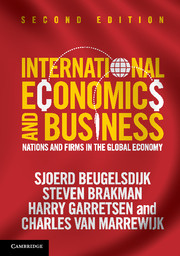Book contents
- Frontmatter
- Contents
- List of figures
- List of tables
- List of boxes
- Preface
- Part I Introduction
- Part II Firms, trade, and location
- 3 Trade, comparative advantage, and competition
- 4 Modern trade theory: the role of the firm
- 5 Trade restrictions and trade policy
- 6 Firms, location, and distance
- 7 Managing across borders
- Part III Capital, currency, and crises
- Part IV Consequences of globalization
- Bibliography
- Author index
- Subject index
6 - Firms, location, and distance
from Part II - Firms, trade, and location
- Frontmatter
- Contents
- List of figures
- List of tables
- List of boxes
- Preface
- Part I Introduction
- Part II Firms, trade, and location
- 3 Trade, comparative advantage, and competition
- 4 Modern trade theory: the role of the firm
- 5 Trade restrictions and trade policy
- 6 Firms, location, and distance
- 7 Managing across borders
- Part III Capital, currency, and crises
- Part IV Consequences of globalization
- Bibliography
- Author index
- Subject index
Summary
Keywords
Distance • Transport costs • Models of exports and multinational activity • Gravity model • Investment motives • Market seeking/efficiency seeking investments • Liability of foreignness • Types of distance • Porter’s Diamond model • Dunning’s Ownership–Location–Internalization model • Firm-specific advantage
Introduction
Chapter 2 introduced the two main types of international business activity, namely exporting and (horizontal and vertical) multinational activity. Chapters 3 and 4 reviewed both classical and modern trade theory; to explain why firms cross borders we argued that location-specific advantages are fundamentally related to the notions of comparative and competitive advantage. We also showed that firms cannot be treated symmetrically as they differ fundamentally in the way they can cross borders and become internationally active (firm heterogeneity). We concluded in Chapter 4 that a pecking order exists with the most productive firms engaging in multinational activity, the medium productive firms active in exports, and the least productive firms active on the domestic market only. Chapter 5 addressed the role of trade barriers and trade policy. This chapter analyses location and distance.
Learning objectives
What role transport costs play in international trade
Understanding the gravity model of international trade, as commonly used in international economics and business
Understanding the microeconomic underpinnings of exporting and the two main types of multinational activity to assess the different types of costs associated with both
Understanding why the liability of foreignness is associated with costs of doing business abroad
Reflecting upon the different types of distance that have to be overcome by internationalizing firms
Understanding the importance of firm-specific advantages to comprehend why firms go abroad
Reflecting upon two major integrative frameworks connecting firms and nations
- Type
- Chapter
- Information
- International Economics and BusinessNations and Firms in the Global Economy, pp. 157 - 189Publisher: Cambridge University PressPrint publication year: 2013

